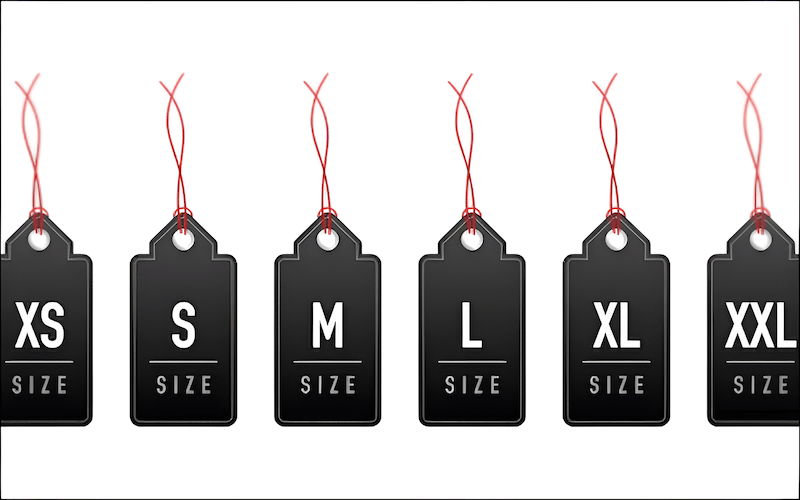Accurate Size Labels: Why They Matter for Brands and Customers
Are you a clothing brand, online retailer, Etsy seller, or fashion designer seeking to thrive in today’s competitive market? Accurate size labeling is a cornerstone of success, particularly in the world of online shopping. Sizing discrepancies lead to high return rates, customer dissatisfaction, and a damaged brand reputation.
This article will comprehensively explore the importance of precise sizing, including customer satisfaction, operational efficiency, and adherence to best practices. Discover practical strategies for creating, choosing, and using size labels effectively, to drive sales and build customer loyalty.
1. The importance of accurate size labels for brand image and customer trust
1.1 Creating a professional look with accurate sizing
Accurate size labels are the first step in ensuring garments fit as intended. Correctly sized garments, reflected by accurate labels, contribute significantly to a polished and professional brand image. Customers perceive a direct correlation between attention to detail and the overall quality of a product.
A high-quality garment should have a high-quality, accurate size label. Even seemingly small details, such as the label’s placement, material, and printing, collectively contribute to a polished and professional image.

1.2 Building customer trust through consistent sizing
Consistent sizing across a brand’s product line is critical for building customer trust and loyalty. Customers who know they can confidently order a size “Medium” from your brand, with the expectation that it will fit reliably, are far more likely to become repeat customers.
In the realm of online shopping, where customers cannot physically try on garments before purchasing, the size label becomes the primary and often only indicator of fit. Sizing consistency builds trust and ensures a positive customer experience. When sizing is predictable and reliable, repeat purchases are more likely.

1.3 Increasing brand visibility and recognition
A well-designed and accurately placed size label, while small, also contributes to brand recognition. The size label subtly reinforces brand identity with every interaction a customer has with the garment. Whether wearing, washing, or storing the garment, the size label is a subtle, yet constant reminder of the brand.
2. Minimizing returns and maximizing customer satisfaction with accurate size labels
2.1 Preventing returns due to poor fit
Inaccurate size labels are a direct contributor to increased return rates, a major pain point particularly for online retailers. The financial costs associated with returns are substantial, including return shipping expenses, processing fees, and the potential loss of the original sale.
Addressing customer service inquiries related to sizing issues adds to these costs. Additionally, the environmental impact of unnecessary shipping, including increased carbon emissions and waste, is a growing concern. Reverse logistics, the process of handling returned goods, further increases expenses and operational complexities.

2.2 Enhancing customer satisfaction through accurate sizing
Accurate sizing directly translates into a positive customer experience. When a garment fits well, the customer is more likely to wear and enjoy it. This positive experience often results in positive reviews and word-of-mouth referrals. Satisfied customers are more likely to become brand loyalists, and share their positive experiences with others.

2.3 Reducing missed sales opportunities
Unclear or inaccurate sizing information can significantly deter potential customers. If a customer is unsure about the fit of a garment, they may hesitate to purchase it. This doubt often leads to customers abandoning a purchase, resulting in a direct loss of revenue. The missed sales associated with inaccurate sizing can significantly impact the business’s bottom line and profitability.
3. Accurate size labels in the e-commerce landscape
3.1 The critical role of size labels in online retail
Accurate size labels are especially crucial in online retail. Online shopping depends entirely on the information presented to the customer; in the absence of physical try-ons, a reliable size label becomes even more important. Size labels, coupled with detailed product descriptions and accurate size charts, guide the customer’s purchasing decisions. The customer is relying on the information provided to make an informed decision.

3.2 Guiding purchase decisions with accurate sizing information
Accurate size labels, used alongside detailed size charts and, when possible, fit models, empower customers to make informed choices. Comprehensive measurement guides and fit finders, if implemented, further assist customers in selecting the correct size, enabling them to make confident purchasing decisions. Clear, consistent, and reliable sizing information directly supports the customer’s selection process.
3.3 Managing customer expectations and reducing dissatisfaction
Accurate sizing information sets realistic expectations for customers. This reduces the likelihood of disappointment and leads to a more positive customer experience when the garment arrives. Providing transparency regarding sizing prevents any surprises, thus reducing returns and negative reviews.
4. Adhering to sizing standards and maintaining consistency
4.1 Understanding general sizing standards
General sizing standards exist across different regions, such as US, UK, and EU sizes. However, these standards can vary slightly between brands, so it’s crucial to know your target market’s typical sizing conventions.
Understanding your market’s expectations is essential for avoiding confusion. The issue of vanity sizing, where brands deliberately label garments with smaller sizes than their actual measurements, adds to these inconsistencies. This can confuse customers.
4.2 The importance of internal sizing consistency
Maintaining consistent sizing within a brand’s product line is vital for building and sustaining customer trust. Internal consistency simplifies the shopping experience for repeat customers; they can confidently order the same size across different styles. This consistency builds trust and encourages repeat purchases.
4.3 The essential tool.
Size labels and sewing labels serve as an essential tool, and you have the option of pre-made versus custom labels, with each offering distinct benefits. Pre-made labels offer convenience, while custom labels provide branding opportunities.
Size labels quickly inform the wearer or potential buyer whether an item might fit them. It is critical that the size labels reflect the actual measurements of the garments to which they are attached.
5. Beyond Garments: The Universal Importance of Accurate Labeling
5.1 Creating a professional presentation across products
The principles of accurate and professional labeling extend beyond garments and apply to a wide range of products, including the packaging of any physical item you sell. Clear, accurate, and professional labeling contributes to a positive customer experience, and a professional image, regardless of the product type.
5.2 Avoiding misinformation and ensuring clarity
Inaccurate labels on any product can lead to confusion, misuse, or incorrect expectations. Clear and concise information on all types of labels is essential to avoid misinformation. These issues can lead to safety hazards and a decline in consumer trust.
6. FAQs about accurate size labels
6.1 What is vanity sizing, and how does it affect size labels?
Vanity sizing is the practice of labeling garments with sizes smaller than their actual measurements. This can mislead customers, making it more difficult to find their true size, and lead to inconsistent sizing across different brands, causing customer frustration.
6.2 How can I ensure my brand’s sizing is consistent?
To ensure consistent sizing, it is essential to use standardized patterns and conduct regular fit tests on a variety of body types. Documenting all measurements carefully is also vital.
6.3 What are the best materials for size labels?
The best material for a size label depends on the garment type. Options include woven labels, which are durable, high-quality, and offer a classic look, making them suitable for a wide range of garments. Heat transfer labels applied directly to the fabric, creating a tagless feel and being well-suited for activewear.
Rubber labels are another option, as they’re durable, water-resistant, and often used for outerwear or swimwear. If customers are unsure of which label is right for their product, a value booster kit, offering a selection of options, is a good suggestion.
6.4 Where should I place size labels on garments?
Common placements include the back neck (center or inside collar), or the side seam (near the hem). Labels should be placed in a location that is easy to find, and the placement should be consistent across all garments for easy identification.
6.5 How can inaccurate size labels increase costs for businesses?
Inaccurate size labels increase costs by leading to higher return rates, damage to brand reputation, and missed sales opportunities.
7. Packlove – Providing services for accurate size labels
Packlove specializes in creating high-quality, custom labels, including accurate size labels, for businesses of all sizes. We offer a wide range of materials, sizes, and printing options to meet your specific needs, ensuring that your labels accurately reflect your brand and adhere to all applicable sizing standards.
With years of experience in the printing and packaging industry, we understand the critical importance of accurate and professional labeling. Our team is dedicated to providing exceptional customer service and helping you create size labels that are both informative and visually appealing.
Contact us today for a free consultation and quote. To complement your size labels, we also offer a variety of packaging solutions, such as Zipper Bags and Poly Mailers, which can further enhance your brand presentation and provide a polished customer experience.
Read more:
In conclusion, accurate size labels are absolutely crucial for all aspects of a clothing business, or any business selling products with size variations. These labels are essential for customer satisfaction, building and maintaining a strong brand reputation, and, ultimately, contributing to overall profitability.
Prioritize accurate sizing and labeling practices as a fundamental part of your business operations, recognizing that this seemingly small detail has a significant impact on your bottom line.Visit Packlove to explore our custom label options and create size labels that accurately represent your brand and elevate the customer experience.






















